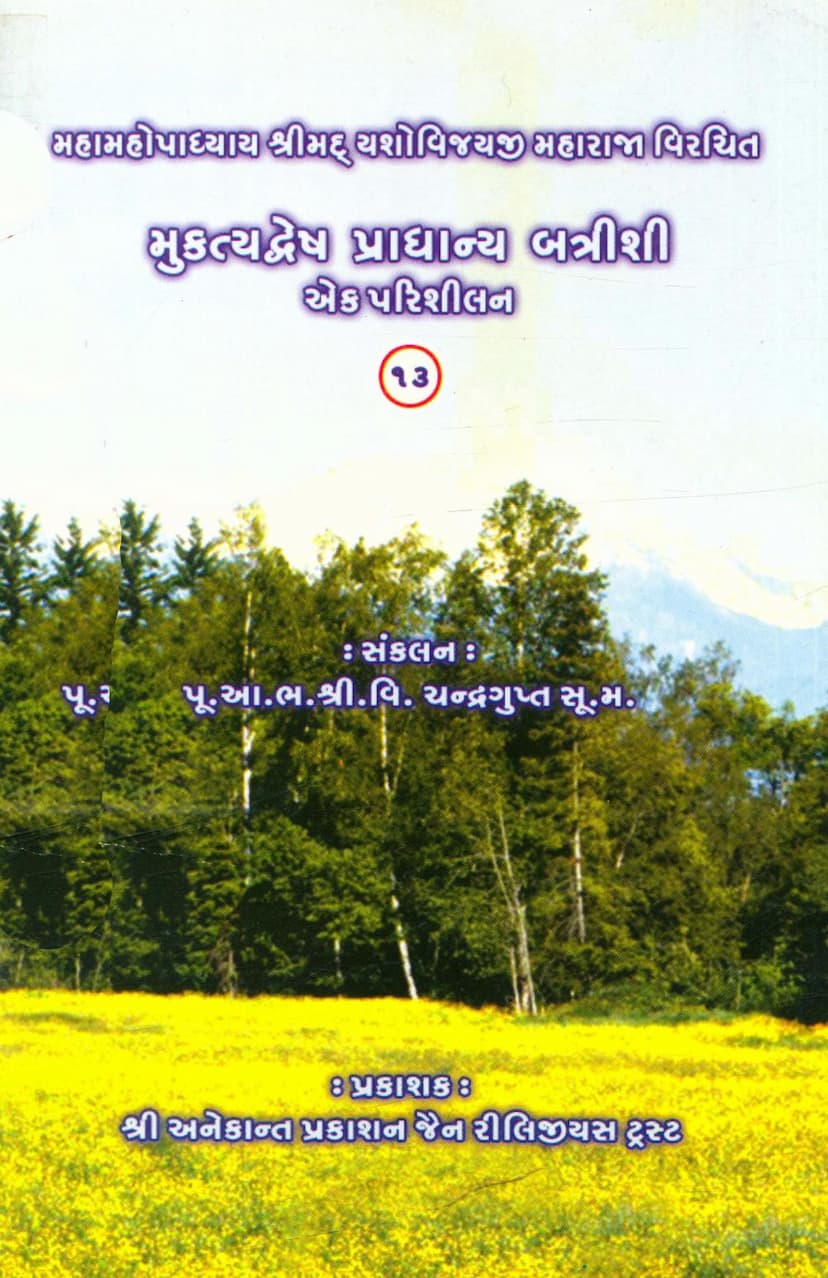Muktyadwesh Pradhanya Battrishi Ek Parishilan
Added to library: September 2, 2025

Summary
Here's a comprehensive summary of the Jain text "Muktyadwesh Pradhanya Battrishi Ek Parishilan" by Acharya Chandraguptasuri:
Title: Muktyadwesh Pradhanya Battrishi Ek Parishilan (A Study of the Thirty-Two Verses on the Primacy of Non-Adversity towards Liberation)
Author: Acharya Chandraguptasuri
Publisher: Shri Anekanth Prakashan, Jain Religious Trust
Core Theme: The central theme of this work is to highlight the paramount importance of "Muktyadwesh" (मुक्ति-अद्वेष), which translates to non-adversity or the absence of aversion/dislike towards liberation (Moksha), as a crucial prerequisite and driving force for all spiritual practices.
Context from Previous Work (Yogapoorvaseva Battrishi): The introductory section explains that a previous work, "Yogapoorvaseva Battrishi," discussed four types of preparatory practices for Yoga: Guru-Deva Puja (worship of spiritual preceptors and deities), Sadachar (virtuous conduct), Tapa (austerities), and Muktyadwesh. This current work focuses specifically on the primacy of Muktyadwesh among these.
The Problem of "Muktyadwesh":
- Apparent Agreement vs. Underlying Aversion: While we may believe we are not averse to liberation, a deeper introspection reveals a subtle aversion or dislike.
- Cause: Deep-seated Ignorance and Attachment to Worldly Pleasures: This aversion stems from deeply ingrained ignorance and an overpowering attachment to the pleasures of the mundane world (samsara). Despite scriptural descriptions of samsara as suffering and liberation as eternal bliss, the allure of worldly comforts makes liberation seem less desirable, and therefore, disliked.
- The Question: The text poses a fundamental question: Is the world or liberation more desirable to us? Answering this honestly is presented as difficult due to ingrained attachments.
The Primacy of Muktyadwesh:
- Essential for Yoga's Effectiveness: Muktyadwesh is presented as the foundational reason why practices like Guru-Deva Puja, Sadachar, and Tapa become genuine spiritual yogas (means to union). Without it, these actions remain mere external rituals.
- Distinguishing True Spiritual Practice: The text differentiates between actions performed with the intent of achieving liberation and those performed for worldly gains (like fame, heavenly pleasures, etc.). Practices done for worldly desires, even if outwardly resembling spiritual ones, can become detrimental, like accepting poisoned food or handling dangerous weapons improperly.
- The Pitfall of Worldly Desire in Practice: Even "pure" ritualistic actions (dravya shramanpanna kriya) become "poisonous" if driven by a strong desire for worldly pleasures. Such actions are condemned as they lead to further entanglement in the cycle of birth and death.
- The Illusion of Merit: Merely performing good deeds without the underlying aspiration for liberation is not truly beneficial in the long run. Fame, wealth, or even heavenly realms achieved through such acts are ultimately temporary and do not lead to the ultimate goal.
Types of Practices (Anushthana) and Their Classification: The text classifies practices into five types based on the intention and the time period (Charmaavarta and Acharmaavarta kal). The primary criterion for a practice to be considered "good" (Sad-anushthana) is its connection to Muktyadwesh.
- Three Misleading Practices (Asad-anushthana/Mithya):
- Vish-anushthana (Poisonous Practice): Driven by a desire for worldly gains like supernatural powers (labdhi), fame, etc. These immediately destroy positive mental states.
- Gara-anushthana (Deadly Practice): Driven by a desire for heavenly pleasures, leading to ruin in future lives after the enjoyment of those pleasures is exhausted.
- Ananushthana (Non-Practice): Performed without proper intention or awareness (sammoha, anabhog), akin to the actions of deluded beings.
- Two True Practices (Sad-anushthana/Satya):
- Taddhetu-anushthana (Practice as a Cause): Arises from a strong desire for liberation (Muktyadwesh) or mild attachment to it.
- Amrita-anushthana (Nectar-like Practice): Performed with deep faith in the path taught by the Jinas, leading directly to liberation.
The Role of "Muktyadwesh" in the Classification:
- Achieving Taddhetu-anushthana: Muktyadwesh is identified as the primary driver for Taddhetu-anushthana. However, a crucial distinction is made:
- Abhavyas (Non-liberatable beings): They might have Muktyadwesh (or rather, indifference), but without the right intention or aspiration for liberation (as they are incapable of it), their practices remain in the lower categories (Vish, Gara, or Ananushthana). Their indifference doesn't qualify as the positive "Muktyadwesh" that leads to liberation.
- Bavyas (Liberatable beings) in Charmaavarta: Those in their final cycle of births (Charmaavarta) possess a specific type of Muktyadwesh, fueled by the contemplation of the true nature of liberation and the transient nature of worldly pleasures. This specific type of Muktyadwesh, often coupled with a desire for liberation itself, fuels the Taddhetu-anushthana.
- "Badhya" (Subduable) vs. "Abadhya" (Unsubduable) Desire: Worldly desires (like for wealth, fame, heaven) are described as either "badhya" (can be overcome through spiritual teachings) or "abadhya" (cannot be overcome).
- If worldly desires are "badhya" and are overcome, Muktyadwesh can lead to true Taddhetu-anushthana and ultimately Amrita-anushthana.
- If worldly desires are "abadhya," even if one has Muktyadwesh, it doesn't lead to true spiritual practices or liberation, as the underlying attachment remains.
- The Nature of Charmaavarta: Beings in the Charmaavarta period are nearing liberation. This proximity fills them with joy, reduces the perception of hardship in spiritual practices, and fosters deeper devotion and adherence to the path.
Benefits of True Muktyadwesh:
- Purification of the Soul: It leads to the cessation of new karmic bondages and the purification of the soul.
- Progressive Stages: It fosters a progressive growth of positive mental states (shubh bhav), leading to enhanced spiritual strength (virya), clear memory (smriti), and stable concentration (samadhi).
- Absence of Fear: As liberation is perceived as close, there is no fear of suffering or obstacles.
- Joy in Practice: Spiritual practices become a source of joy, not suffering, due to the anticipation of liberation.
- Attainment of Qualification: It ultimately grants the qualification or eligibility (adhikaritva) for true Yoga and the ultimate goal of liberation.
Conclusion: The text strongly emphasizes that true spiritual progress and the effectiveness of all religious practices are contingent upon Muktyadwesh—a profound, non-averse, and desiring attitude towards liberation. Without this essential inner disposition, even seemingly virtuous actions can be superficial or detrimental. The study aims to guide individuals to cultivate this crucial quality for their spiritual journey.